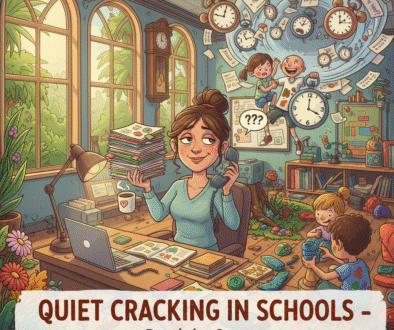A playful illustration of boys and girls learning differently in Gurgaon schools. A boy digs a hole while a girl builds a castle, highlighting the brainy, hands-on, and creative ways children explore and learn in classrooms and playgrounds.

Why My Son’s “Etc.” and School Rules Led to a Showdown
Being a mom and an educator is like juggling flaming torches while riding a unicycle—except the torches occasionally scream, and the unicycle has a mind of its own. That’s how it felt the day I had to explain to my son’s teacher why every answer he wrote ended with… “and etc.”
Yes, “etc.”—the punctuation that triggered a parent-teacher showdown, blending humor, frustration, and revelation. My son’s reasoning? If the teacher already knows the answer, why spell it out? “They’re smart, right?” he shrugged.
At the parent-teacher meeting, I tried to explain:
“He genuinely believes he’s saving everyone time. Repeating things feels pointless to him.”
Cue eye-rolls, sighs, and a mix of pride and exasperation. That little “etc.” moment wasn’t just funny—it was a wake-up call about boys and girls learning differences and how schools often misinterpret unique learning styles.
The “Etc.” Chronicles: When Efficiency Meets Detention
It all began when my son decided repetition was beneath him. For him, if the teacher already knows the answer, why spell it out? But when he added “etc.” to his exam answers, the school called. Complaints of “lack of effort” were raised.
I left the meeting with mixed feelings: pride in his logic, frustration with the system, and a reminder that education often fails to see children as individuals.
The Heart-Drawing Debacle: When Marks Meet Artistry
Another incident: my son got marked down in science because his heart drawing wasn’t colorful or textbook-perfect. Girls, who memorized the diagram and added vibrant hues, scored higher.
His reaction?
“Why does it matter what it looks like? It’s just a heart.”
Classic boy logic: function over form. Boys focus on purpose, girls on presentation—a neurological difference often ignored in classrooms.
Why Boys and Girls Learn Differently
Research shows boys and girls have distinct learning styles rooted in brain wiring. Boys excel in spatial and hands-on tasks, while girls’ faster-developing language centers help them with verbal and detail-oriented tasks.
These differences aren’t absolute, but they matter. In the sandbox, boys flung sand like tiny volcanic eruptions, while girls built intricate castles and strategized together. Both learned—just differently. Boys via movement and experimentation, girls via collaboration and structure.
Even toddlers reveal these tendencies, which continue into school years, influencing classroom behavior, learning preferences, and assessment outcomes.
When Discipline Becomes Gendered
My son often complained:
“Why am I punished when I upset a girl, but girls’ mischief is overlooked?”
It’s not just anecdotal. Studies show boys are disciplined more harshly for behavior deemed disruptive, even if developmentally normal. Boys’ natural energy and slower prefrontal cortex development are often misread as misbehavior.
Think of it this way: boys are fireworks, girls are candles. When fireworks spark, someone yells. When candles flicker, it’s art. Both are natural, both are learning, but only one gets a detention slip.
The Hole-Digging Phenomenon
Picture a playground in Gurgaon: a boy digs a colossal hole, completely absorbed. Nearby, a girl arranges twigs with meticulous precision. Both are learning intensely, yet their approaches differ:
-
Boys: messy, hands-on, exploratory
-
Girls: structured, collaborative, detail-oriented
Even in exams, these tendencies appear. Boys may prioritize conceptual understanding, girls may emphasize presentation and detail. My son’s “etc.” wasn’t laziness—it was mastery of conciseness.
Raising Kids and Teaching in Gurgaon
From classrooms to playgrounds, boys climbing walls and girls orchestrating role-play, every scene in Gurgaon schools highlights one truth: children learn differently, and one-size-fits-all education misses their genius.
To help children thrive:
-
Observe how they explore: movement vs. structure.
-
Celebrate strengths, not conformity.
-
Adapt classroom tasks to fit different learning styles.
-
Advocate for gender-aware teaching in schools.
Closing Thought
Parenting and teaching are messy, chaotic, and full of laughter, pride, and spilled tea. The goal isn’t conformity—it’s noticing, valuing, and nurturing unique strengths.
Every “etc.”, every messy heart, every sandbox adventure is a child’s brain at work. Pause and look closer. That chaos? That order? That’s brilliance unfolding in real-time.
What’s your take? Have you seen these quirks in your kids or students? Share your stories and help rethink how education can truly serve every child.


